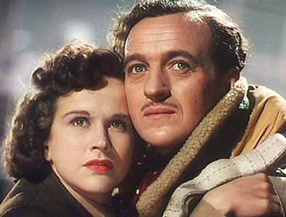Classic Movie Review: A Matter of Life and Death
By Josh Spiegel
March 23, 2010
What makes A Matter of Life and Death so charming, so livable, and so enviable to anyone with a mind to make movies is not just the script, full of humor and life, but the actors, all of whom seem to so embody their characters that you wonder how they can do so much with seemingly so little. David Niven, future Oscar winner, plays Peter as a smart and dashing rogue, a man troubled by what appear to be realistic hallucinations in the form of his conductor, but not too troubled to ask for some tea or watch a game of ping-pong. Kim Hunter, another future Oscar winner, plays June, the personification of the phrase "cute as a button". What red-blooded man wouldn't want to move heaven and earth to live out a second life with her? Their chemistry, while never reaching the erotic peaks attained in the next film from the Archers, Black Narcissus, is still white-hot.
In a winning and unique performance as Dr. Reeves, the man who ends up being Peter's worldly and ethereal counsel, is Roger Livesey, the same man who played Colonel Blimp. Here, he doesn't age, but his wit, his smarts, and his camera obscura, a device which allows him to see all in his village, if from a darkened vantage point, make the character as instantly iconic as Blimp or Thomas Colpeper from A Canterbury Tale. Other notable performances come from Marius Goring, as the French conductor; and Raymond Massey as the prosecuting counsel for the case of Peter's life, a true American patriot felled by the first bullet of the American Revolution who, for obvious reasons, despises all things British.
One of the many flourishes that stick out here is the literal stairway to Heaven (though, cleverly, Powell and Pressburger never come out and call the place where the dead go Heaven), a massive moving platform that heads up endlessly into the clouds. The production design, in general, is fantastic, managing to seem expansive and epic even if the story is decidedly meant to seem unpretentious and uninterested in broadening the scope. As is always the case with films from The Archers, the story never seems contrived (even if you're asked early on to suspend your disbelief), and never seems like something you've seen before.
Jack Cardiff's cinematography, mixing Technicolor during the scenes set on Earth and black-and-white during the Heaven-set sequences, is splendid and stunning. Here was a man who knew how to make the world come alive, color or not. One of the most haunting shots of the film comes early and is set in Heaven, as some of the recent dead peer down through large holes, with the camera facing towards them. Still, the color photography is as lush as anything he ever put on screen, rivaling his work in The Red Shoes and Black Narcissus. His work with Powell and Pressburger is, no surprise, second to none.
I realize that I'm late to this party; frankly, if it wasn't for the diligent and tireless work done by Martin Scorsese, and the mention of The Life and Death of Colonel Blimp courtesy of Roger Ebert in his Great Movies column, I don't know if I'd know much about Powell and Pressburger. That said, I've discovered their films and am happier for doing so. The stories they tell are fully lived in. Without seeming like they're working to do so, these two men built characters, towns, lives, worlds. From fantasy to fable, the war to the ballet, the smallest aspect of nature to the biggest question a person could ever have, the Archers set their sights high, and often hit their targets directly, as evidenced in their logo. A Matter of Life and Death is one of their finest efforts, if not their best, and a movie that you must see as soon as you can.
Continued:
1
2
3




